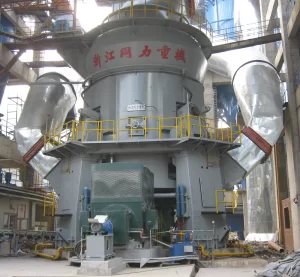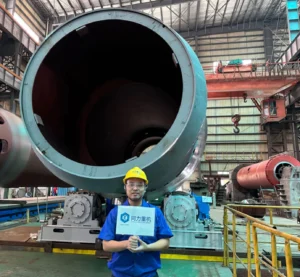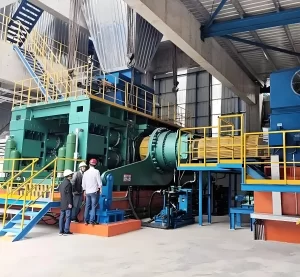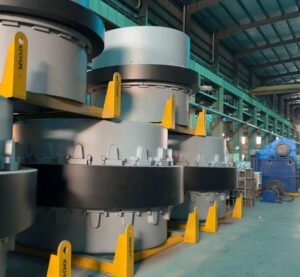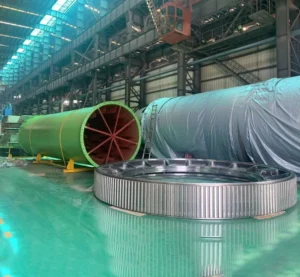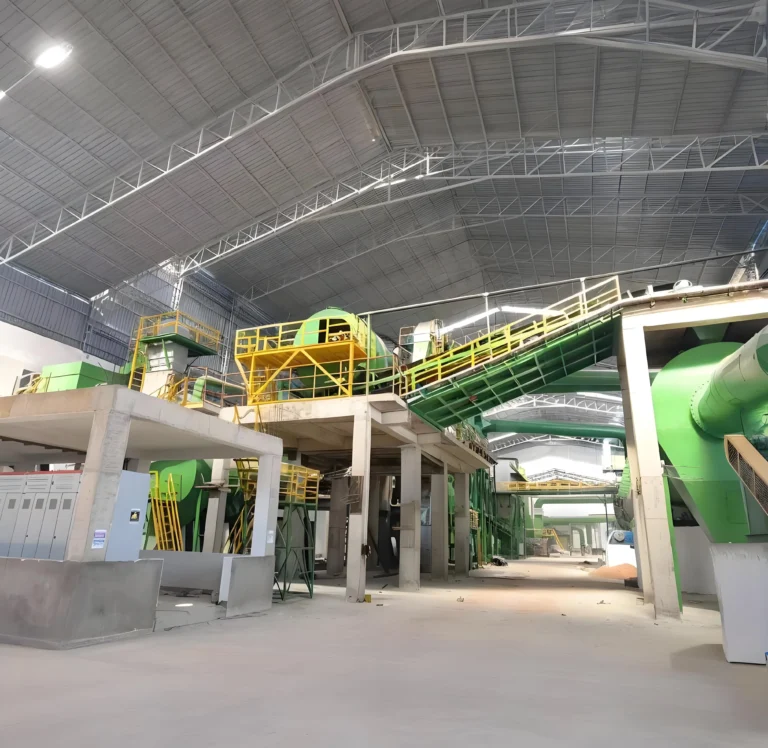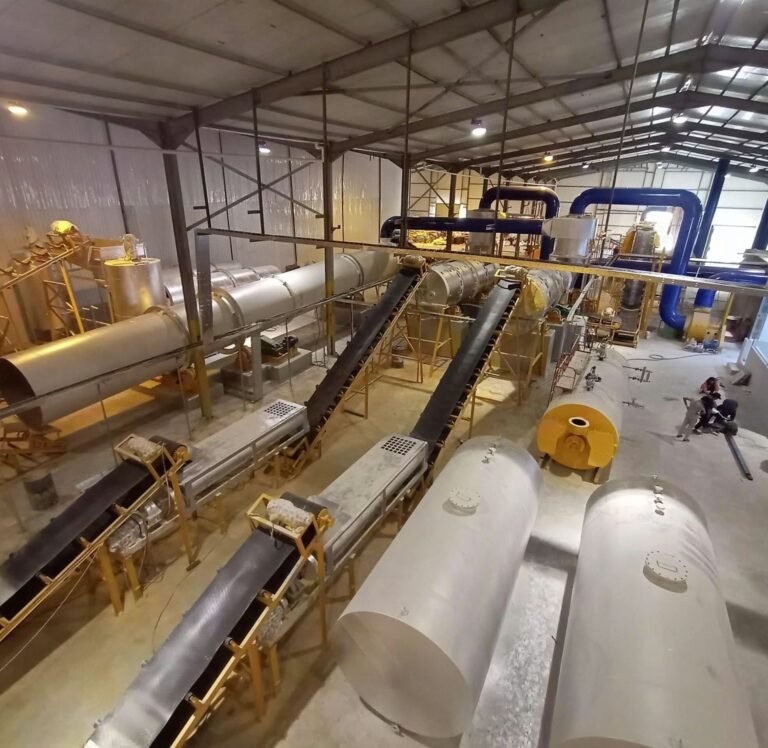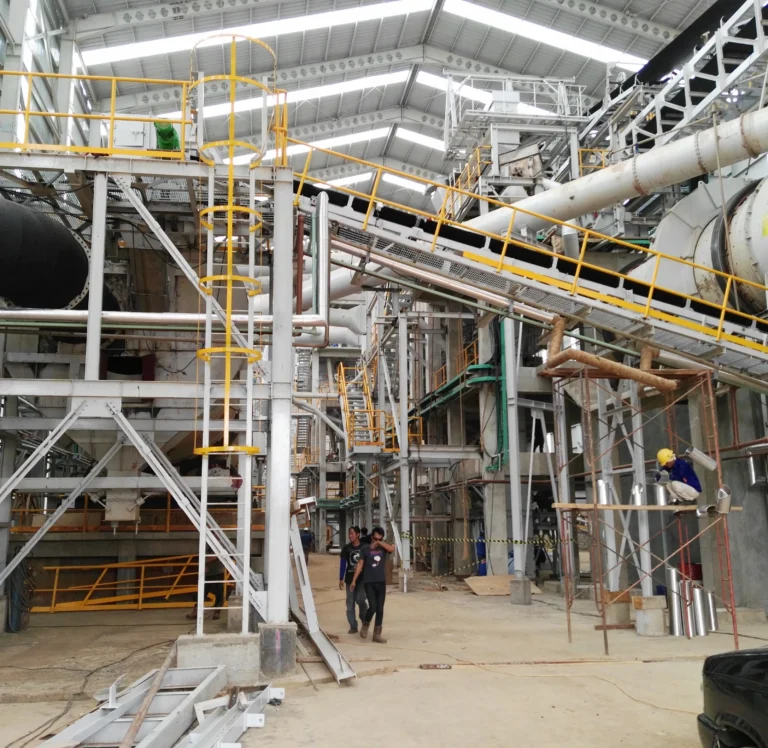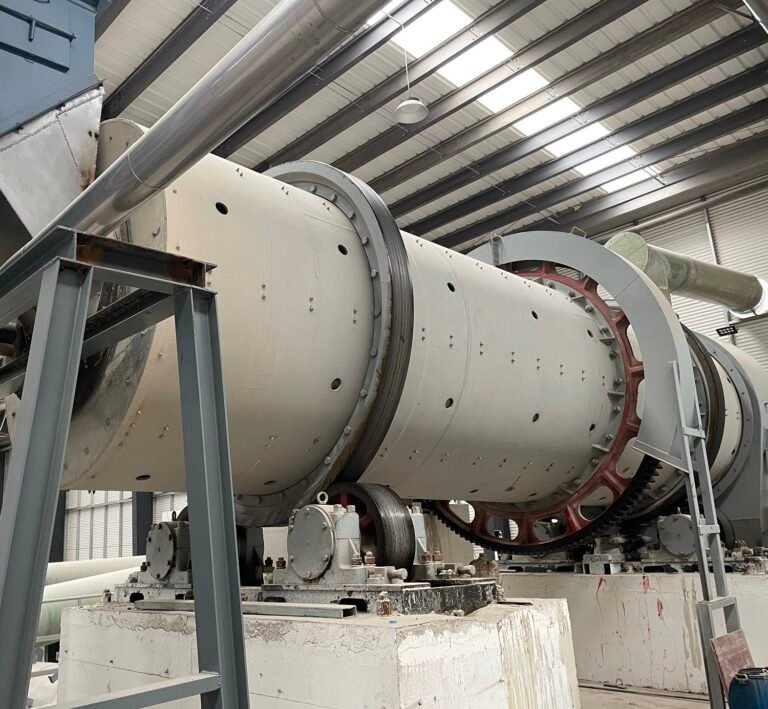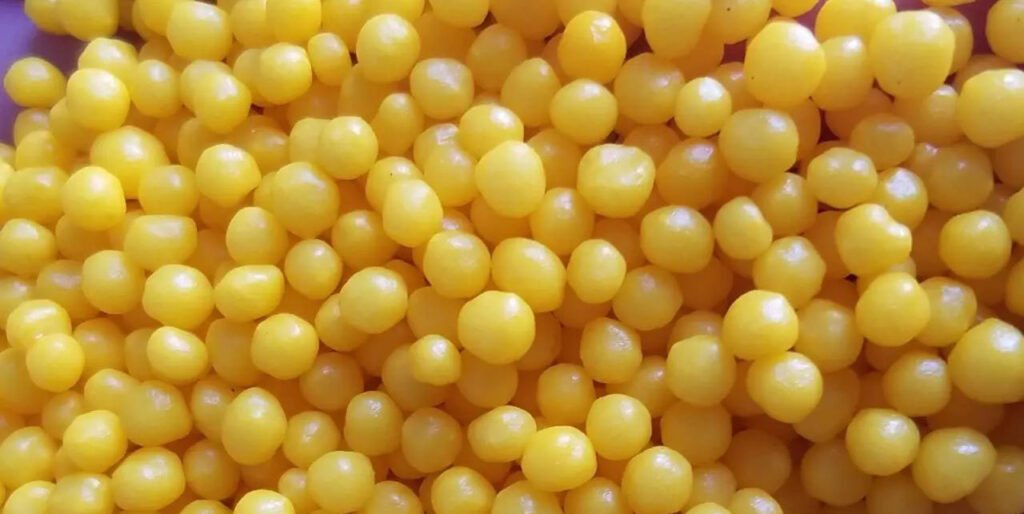
Sulfur-coated urea (SCU) is a new type of fertilizer technology. Urea sulfur coating is a controlled-release fertilizer that coats the surface of urea particles with a sulfur coating and auxiliary materials such as wax and resin. The sulfur layer is physically covered and microbial decomposition is used to slowly release nitrogen. Since traditional NPK fertilizers have a fast effect but a short duration, sulfur-coated urea solves this problem in order to achieve sustainable and efficient fertilization. Nutrients will continue to release as they are infiltrated or discharged into the atmosphere, so this slow release rate can ensure that plants absorb nitrogen for a long time, increase the nitrogen fertilizer utilization rate from 30%~40% to 50%~70%, reduce volatilization and leaching pollution, and sulfur decomposition can acidify alkaline soils and provide sulfur elements. The production adopts molten sulfur spraying or powder sulfur coating technology, which is suitable for field crops such as rice and corn and cash crops. The release cycle is 30~120 days, and the cost is lower than resin-coated urea. When applying, attention should be paid to moisture-proof storage and matching with crop needs. This article will comprehensively introduce the advantages, disadvantages, production process, production equipment, and future market prospects of sulfur-coated urea from all aspects.
How Sulfur‑Coated Urea Works: Science Behind the Slow‑Release Coating
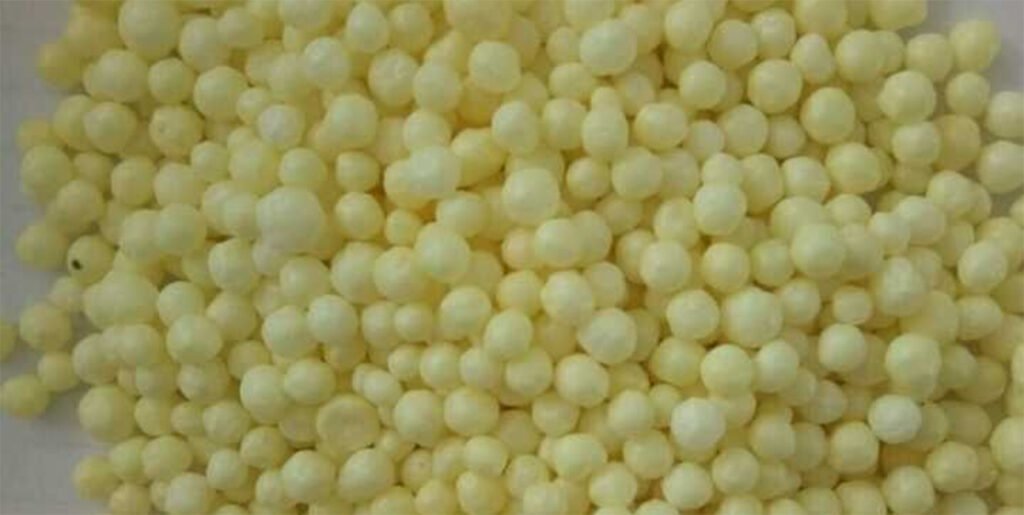
The working principle of sulfur-coated urea (SCU) is based on the synergistic mechanism of physical barrier, biodegradation and nutrient release: the sulfur coating and sealing layer wrapped on the surface of urea particles form a hydrophobic barrier, which delays the infiltration of water and inhibits the rapid dissolution of urea, extending the nitrogen release cycle from 7 to 15 days of traditional urea to 30 to 120 days. At the same time, with the help of the gradual decomposition of the sulfur layer by sulfur-oxidizing bacteria in the soil, urea is slowly released in a "gradual impregnation" manner, forming a uniform nitrogen diffusion pattern, which not only reduces leaching and volatilization losses, but also ensures the long-term effectiveness of nitrogen in the soil. When water dissolves urea, the decomposition process of the sulfur coating layer dynamically matches the needs of the crop growth cycle, allowing plants to continuously and efficiently absorb nitrogen, not only providing regular nutrient supply for crops, promoting plant growth by optimizing the root environment, but also achieving yield increase by building a sustainable and reliable crop production system. At the same time, sulfur decomposition can also supplement sulfur elements for plants and acidify alkaline soils, increasing the nitrogen fertilizer utilization rate from the traditional 30% to 40% to 50% to 70%.
What factors affect the effectiveness of sulfur-coated urea fertilization?
The factors that affect the fertilization effect of sulfur-coated urea can be divided into five categories: the coating thickness of the fertilizer itself and the ratio of auxiliary materials; soil temperature, humidity, pH value and texture; crop types and nitrogen requirements during the growth period; fertilization depth, storage conditions and mixing with other fertilizers; regional climate conditions and irrigation methods. Now let's take a deep look:

1. Coating thickness and structure
First, the characteristics of the fertilizer itself. The thickness and structure of the coating layer have a significant impact on the fertilizer efficiency. Studies have shown that when the sulfur coating is too thin (less than 0.1mm thick), the nitrogen release can reach more than 50% within 15 days, which can easily lead to early nutrient loss; while when the coating is too thick (more than 0.5mm), the nitrogen release within 30 days is less than 20%, which is difficult to meet the early growth needs of crops. Among the auxiliary materials, the proportion of sealing layer materials is also crucial. For example, when the wax layer accounts for more than 20%, it will significantly inhibit the action of sulfur-oxidizing bacteria and extend the nitrogen release cycle by 20-30 days.
2. Soil environmental conditions
The second is soil environmental conditions. Soil temperature affects the activity of sulfur-oxidizing bacteria. When the temperature is 25-35℃, the activity of sulfur-oxidizing bacteria is the best, which can make the nitrogen release of sulfur-coated urea reach 60%-70% within 60 days; when it is below 10℃, the release is less than 30%. Soil pH value is also critical. In alkaline soils with a pH value of more than 8.0, the decomposition rate of the sulfur layer is about 30% slower than that of neutral soil. In addition, soil texture also has an impact. The nitrogen leaching loss rate in sandy soil is 15-20% higher than that in clay soil.
3. Demand for crop growth
The next is the demand for crop growth. Different crops have different demands for nitrogen. The nitrogen requirement of corn from the jointing stage to the booting stage accounts for 50-60% of the entire growth period. If the sulfur-coated urea releases less than 40% of nitrogen during this stage, it will affect the yield; the nitrogen requirement of rice during the tillering stage accounts for about 40%, and the appropriate sulfur-coated urea should ensure that the corresponding proportion of nitrogen is released during this stage.
4. Application management method
Fourth, the application management method. The depth of fertilization has a significant impact on fertilizer efficiency. Fertilization 10-15cm deep and covered with soil can increase nitrogen utilization by 20-30% compared with surface application; during storage, a humid environment with a relative humidity of more than 70% will cause the sulfur coating to decompose 15-20% earlier within 1 month. Mixing with alkaline fertilizers will neutralize the acidic substances produced by sulfur decomposition, causing the nitrogen release rate to slow down by 10-15%.
5. External environmental factors
Finally, there are external environmental factors. Climate conditions have a significant effect. In rainy areas with annual precipitation exceeding 1000mm, the nitrogen release of sulfur-coated urea within 60 days is 25-30% higher than that in arid areas; and in low-temperature areas with an average temperature below 15℃, the nitrogen release cycle will be extended by 30-40 days. Under different irrigation methods, drip irrigation can make nitrogen utilization reach 65-75%, which is 20-30% higher than flooding irrigation.
SCU vs. Other Urea Granule Coated Fertilizers: Polymer, Zinc, & Beyond

Which one you shoud choose? SCU or polymer coated or zinc coated urea?
- SCU is preferred: it is suitable for sulfur-requiring soils (such as sulfur-deficient areas) and base fertilizers for field crops, taking into account sulfur nutrition and slow-release effects, and the cost is moderate.
- Polymer coating is preferred: it is suitable for high-value-added economic crops and precision fertilization scenarios (such as drip irrigation), pursuing long-term stable nitrogen supply and environmental friendliness (if degradable materials are used).
- Zinc coating is preferred: it is suitable for zinc-deficient soils and zinc-sensitive crops (such as rice and potatoes), which need to supplement zinc nutrition and improve crop resistance, but the application amount needs to be controlled to prevent zinc accumulation.
| Feature / Characteristic | SCU (Sulfur-Coated Urea) | Polymer-Coated Urea | Zinc-Coated Urea | Other Coated Ureas (e.g., Bio, Micronutrient) |
| Main Coating Material | Sulfur (with wax/sealant) | Synthetic polymers | Zinc oxide or zinc sulfate coating | Bio-agents, boron, copper, humic acid, etc. |
| N Release Mechanism | Microbial & physical degradation | Osmotic diffusion | Dissolution + microbial action | Varies by additive |
| Release Rate / Longevity | Moderate (weeks to few months) | Controlled, slow & steady (weeks–months) | Quick to moderate | Depends on coating; often quick to medium |
| Environmental Impact | Moderate sulfur runoff risk | Lower leaching/volatilization | May reduce leaching, adds Zn | Depends on additive; micronutrients help soil |
| Cost | Moderate | High | Slightly higher than urea | Varies – moderate to high |
| Benefits | Improves sulfur levels; moderate N control | Excellent N control; lower losses | Adds zinc (a key micronutrient) | Enhances soil health or micronutrient supply |
| Drawbacks | Brittle coating; inconsistent release | Expensive; may have plastic residue | Less control on N release | Unpredictable release; quality varies |
| Typical Use Cases | Field crops, cost-conscious growers | High-value crops, precision farming | Zn-deficient soils | Organic/precision agriculture |
| Visual Appearance | Yellowish granules | Smooth, often colored granules | White or slightly grayish granules | Depends on coating; often speckled or uniform |
1. Release mechanism:
- A. SCU (sulfur coated urea) achieves slow release through a triple mechanism. First, under the action of soil moisture, the sulfur layer will gradually dissolve to form micropores, prompting urea to diffuse out; second, soil microorganisms oxidize the sulfur layer to generate sulfuric acid to destroy the membrane structure, thereby releasing urea; finally, water vapor penetrates the membrane to dissolve the internal urea, forming osmotic pressure to break the membrane. This composite release mechanism makes its nutrient release greatly affected by the soil environment.
- B. Polymer coated urea relies on membrane controlled release technology, and its nutrient release is mainly controlled by material properties and temperature changes. Commonly used resin materials such as acrylic acid and polyurethane are hydrophobic, which can delay water penetration and thus control the release rate of urea. At the same time, the increase in temperature can accelerate the expansion and diffusion of the membrane, so that the nutrient release is better synchronized with the fertilizer requirement of crops, and precise fertilizer supply can be achieved.
- C. The release mode of zinc coated urea is relatively diverse. Zinc encapsulates urea in the form of complexes or inorganic salts. On the one hand, when zinc salts dissociate in soil solution, urea will dissolve and release simultaneously; on the other hand, if degradable materials such as lignin and oxidized starch are used as zinc carriers, zinc and nitrogen will be gradually released through the decomposition of the coating. In addition, the formation of complexes between zinc ions and urea can also slow down the hydrolysis rate of urea, indirectly extending the nitrogen supply cycle.
2. Technical parameters:
- A. SCU coating is mainly composed of 80% - 90% sulfur, 2% - 3% sealant (such as microcrystalline wax, polymer wax) and bactericide. Its physical and chemical indicators are nitrogen content of 32% - 37%, sulfur content of 8% - 20%, sulfur layer thickness of 40 - 100 microns, compressive strength ≥ 30N, and can effectively resist mechanical damage. The quality evaluation uses 7-day static nitrogen dissolution rate (initial dissolution rate ≤ 12%) and 28-day cumulative dissolution rate (≤ 75%) to measure the sustained release performance.
- B. Polymer coated urea coating materials include acrylic resin, polyurethane, etc., and some products add bio-based materials to improve degradability. The nitrogen content is 42% - 46%, the coating thickness is 80 - 150 microns, and the coating rate accounts for 10% - 15% of the total mass. By adjusting the film thickness and porosity, a parabolic (Q=k√t) or zero-order release (Q=kt) kinetic model can be achieved to precisely control nutrient release.
- C. The zinc-coated urea coating is composed of inorganic zinc salts (such as ZnSO₄, ZnO) or organic chelated zinc (such as EDTA-Zn) and a degradable carrier (lignin, oxidized starch). Nitrogen content ≥46%, zinc content ≥0.02% (chelated type can reach 1% - 2%), particle size 1.18 - 3.35mm, and coating thickness varies depending on the process (such as spraying method < 50 microns). The release characteristics require an initial dissolution rate (1 day) ≤15%, a 28-day cumulative dissolution rate ≤80% (slow-release products), and the formula needs to be optimized to ensure the synchronization of zinc and nitrogen release.
3. Release duration:
- A. The release duration of SCU is relatively flexible. When the sulfur layer is thin or in a high temperature and humid environment, its release period is usually 30-90 days; when the sulfur layer is thick or in a low temperature and dry condition, the release time can be extended to 90-180 days, so it is necessary to choose the appropriate type according to the actual environment and crop needs.
- B. The release duration of polymer-coated urea is clearly classified. Standard products such as polyurethane coating have a release period of 3-6 months, and can achieve precise controlled release by adjusting the film thickness and opening rate; long-term products use materials such as urea-formaldehyde resin, some of which can reach 12 months, suitable for crops that require fertilizer for a long time.
- C. Conventional zinc-coated urea products are mainly wrapped with inorganic zinc salts, so they release quickly and last for 20-60 days; while slow-release products using degradable materials or complexing technology can extend the release duration to 60-120 days, meeting the staged fertilizer requirements of different crops.
4. Efficiency under different conditions:
- A. The nutrient release efficiency of SCU is significantly affected by a variety of environmental factors. For every 10℃ increase in temperature, its release rate increases by 2-3 times, and high temperature seasons are prone to excessive early release; moist soil can accelerate the dissolution of the sulfur layer, while the release rate will decrease by 50% under drought conditions (soil moisture content < 60%); in acidic soil, the sulfur oxidation process is accelerated, and alkaline soil may delay decomposition. When used, it needs to be used with a conditioner to optimize the effect.
- B. Polymer-coated urea is sensitive to temperature, and temperature is the core factor driving its nutrient release. Temperature-controlled resin products can adjust the release rate with seasonal changes. Its coating has strong impact resistance, is suitable for mechanical sowing or blending fertilizer production, and has a low particle breakage rate. In addition, the fertilizer is not significantly affected by soil microorganisms or pH, but long-term water accumulation may cause the coating to rupture, affecting the controlled release effect.
- C. Zinc-coated urea has obvious differences in performance under different soil conditions. In alkaline soil (pH>6), zinc ions are easily fixed and their effectiveness is reduced; in acidic soil, zinc activity is high, but the application amount needs to be controlled to avoid accumulation. For rice, corn and other crops that are sensitive to zinc, the application of this fertilizer can significantly promote root development and photosynthesis, and increase yields, but care should be taken to avoid direct mixing with phosphate fertilizers to prevent the formation of zinc phosphate precipitation and reduce utilization.
5. Cost and Application:
- A. The cost of SCU is about 2-3 times that of ordinary urea, mainly because of the high cost of sulfur and sealants (such as microcrystalline wax and diatomaceous earth). It is widely used in field crops such as corn and wheat, which can reduce the number of topdressing and increase the nitrogen utilization rate from 30%-40% of ordinary urea to 60%-70%; in the cultivation of economic crops such as vegetables and fruits, it can not only provide nitrogen, but also improve the disease resistance and quality of crops.
- B. The cost of polymer-coated urea is 5-10 times that of ordinary urea due to resin materials and complex coating processes (such as fluidized bed and spray drying). It is mostly used in high-end agricultural fields such as horticulture and greenhouse crops, which can achieve "one-time fertilization, effective throughout the season" and reduce labor input; it is also often combined with drip irrigation systems to achieve efficient fertilization by accurately controlling the film thickness to match the crop fertilizer requirement curve.
- C. The cost of zinc-coated urea is slightly higher than that of ordinary urea, and the cost of zinc additives accounts for about 5% - 15%, which is lower than that of slow-release products. It is suitable for zinc-deficient soils such as calcareous soils and saline-alkali lands, as well as zinc-sensitive crops such as potatoes and rice. It can be used as base fertilizer or seed fertilizer, but it must avoid direct contact with seeds to prevent seed burning. Reasonable application can increase yield by 10% - 20% and improve crop resistance.
6. Environmental impact:
- A. SCU has two-sided effects on the environment. Its positive effect is that sulfur is oxidized to produce sulfuric acid, which can acidify alkaline soils, and there is no residue after the coating is degraded; but in hot and rainy areas, it may increase the risk of nitrogen leaching, and excessive sulfur may also cause soil acidification, and lime and other substances are needed to adjust the soil pH.
- B. Polymer-coated urea can significantly reduce ammonia volatilization (reduction of 50% - 70%) and N₂O emissions (reduction of 40% - 60%), effectively reducing greenhouse gas and air pollution. However, traditional resin materials (such as polyethylene and polyurethane) are not biodegradable, and long-term application may cause soil microplastics to accumulate, threatening the soil ecological environment.
- C. When zinc-coated urea is applied in appropriate amounts, zinc, as an essential trace element for plants, can improve crop nutrition and soil health. However, excessive application or poor soil zinc fixation capacity may lead to zinc enrichment in the food chain, endangering human health; although some coating materials are degradable, inorganic zinc salts may still remain in the soil and should be used with caution.
Benefits of Sulfur‑Coated Urea: Boosting Crop Yields & Cutting Nitrogen Loss

1. Precise and long-term nutrient supply to boost corp yields:
SCU achieves slow release of nitrogen through sulfur coating, and the release cycle is usually 40-90 days, and can be flexibly adjusted according to the coating thickness and environmental conditions. This feature makes nitrogen release highly consistent with the growth stage of crops, and continuously and stably supplies nutrients during different growth periods of crops. For example, during the growth of corn, from the seedling stage to the jointing stage and the booting stage, SCU can release nitrogen on demand, avoiding excessive growth caused by excessive nitrogen fertilizer in the early stage and reduced production caused by lack of fertilizer in the later stage.
2. Significantly improve the utilization rate of nitrogen fertilizer and cutting nitrogen loss:
After traditional urea is applied to the soil, it is easy to cause a large amount of nitrogen loss due to ammonia volatilization, leaching and other channels, and the utilization rate is only 30%-40%. SCU, by means of its coating, can reduce the direct contact between urea and soil urease, slow down the rate of urea hydrolysis to ammonium nitrogen, and reduce the nitrogen dissipation into the atmosphere in the form of ammonia. At the same time, the slow release characteristic reduces the risk of nitrate nitrogen loss with water, and increases the nitrogen fertilizer utilization rate to 60%-70%.
3. Reduce production costs and labor intensity:
Although the unit price of SCU is higher than that of ordinary urea, it can reduce the amount of nitrogen fertilizer by 20%, which reduces the cost of fertilizer purchase in the long term and overall. In addition, due to the long-lasting fertilizer effect of SCU, the number of topdressing can be reduced during the crop growth cycle. For example, in wheat planting, the use of ordinary urea may require 2-3 topdressing, while the use of SCU only requires 1 base fertilizer or 1 base fertilizer plus 1 small amount of topdressing, which greatly reduces the labor costs of manpower, machinery, etc.
4. Good environmental friendliness:
The loss of nitrogen caused by the large-scale use of traditional urea will cause environmental problems such as eutrophication of water bodies, soil compaction and acidification, and greenhouse gas emissions. SCU reduces nitrogen leaching and volatilization, effectively reducing pollution to soil, water and atmosphere. Taking water protection as an example, reducing nitrogen leaching can reduce the risk of blue algae blooms in rivers and lakes and maintain ecological balance.
5. Wide applicability:
SCU has good adaptability to different types of soils and crops. It can play a slow-release effect in acidic and alkaline soils. In alkaline soils, its release process can also alleviate soil alkalinization to a certain extent; in terms of crops, it is applicable to both field crops such as corn and wheat, and cash crops such as vegetables and fruit trees. In addition, for some crops that also require sulfur, it can also supplement sulfur nutrition, promote crop protein synthesis, and enhance crop stress resistance.
SCU vs. Conventional Urea: Which Is Better for Your Soil & Budget?
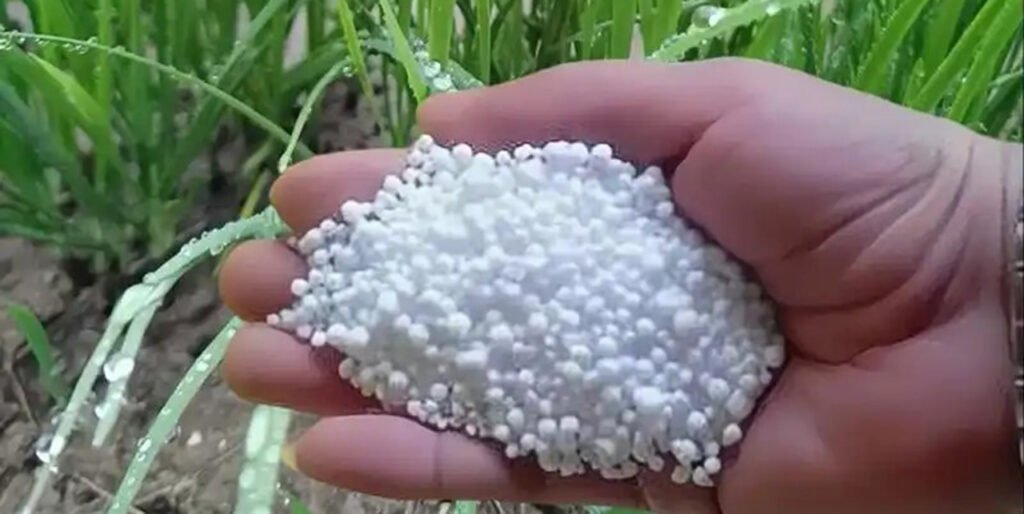
| Comparison Dimension | SCU (Sulfur-Coated Urea) | Traditional Urea |
| Nutrient Release Pattern | Sulfur coating degrades slowly, releasing nitrogen over 40–90 days, synchronizing with crop growth and avoiding "burst release". | Highly water-soluble; releases nitrogen rapidly after application, peaking within 2–3 weeks. |
| Nitrogen Loss Risk | Leaching loss reduced by 30%, volatilization loss reduced by 50%, nitrogen use efficiency increases to 50%–60% (vs. 30%–40% for traditional urea). | Nitrogen easily lost through leaching or volatilization as ammonia; losses can exceed 50% during rainy seasons or in sandy soils. |
| Impact on Soil Microbes | Gradual nitrogen supply prevents drastic fluctuations in soil nitrogen levels, maintaining microbial balance and promoting beneficial microbes (e.g., nitrogen-fixing bacteria). | Short-term high nitrogen concentrations may suppress some microbial activity; long-term use may reduce soil microbial diversity. |
| Soil Structure Improvement | Sulfur coating mildly acidifies soil upon degradation (suitable for alkaline soils) and reduces salinization risk (due to lower single-application nitrogen rates). | Long-term overuse may cause soil compaction (ammonium nitrogen converts to nitrate, releasing H⁺ ions), and salt accumulation is more likely in arid areas. |
| Environmental Friendliness | Reduces water eutrophication (less nitrogen runoff) and greenhouse gas emissions (nitrous oxide), aligning with green agriculture practices. | Unabsorbed nitrogen may pollute groundwater; volatilized ammonia contributes to air pollution, resulting in higher environmental costs. |
1. Impact on soil
SCU releases nitrogen slowly through sulfur coating, with a release period of 40-90 days, which is synchronized with the fertilizer needs of crops. The nitrogen utilization rate is increased to 50%-60%, reducing leaching by 30% and volatilization losses by 50%. It can also slightly acidify alkaline soils, making it suitable for sandy, saline-alkali land and plots with high environmental protection requirements. Traditional urea is highly water-soluble, and the nitrogen concentration reaches a peak within 2-3 weeks, which can easily lead to nutrient loss. Long-term application may aggravate soil compaction, and is suitable for short-term fast-growing crops with good fertilizer retention.
2. Price and cost-effectiveness:
The unit price of SCU is 15%-30% higher, but the application amount can be reduced by 20%-30%, and the labor for topdressing can be saved with one basal application, so the overall cost is more than 20% lower than that of traditional urea. Taking 100 mu of corn as an example, the total investment of SCU is 13,500 yuan, while the labor for traditional urea plus topdressing is 17,000 yuan. In addition, SCU can increase crop yield by 10%-15%, and the quality improvement brings a premium, which has better long-term cost-effectiveness.
| Cost Type | SCU (Sulfur-Coated Urea) | Traditional Urea |
| Unit Price | 15%–30% higher per ton due to coating process costs. For example, if traditional urea costs $347/ton, SCU costs around $389–$444/ton. | Lower cost, generally $347–$389/ton. Suitable for short-term investments with limited budgets. |
| Application Rate | Nitrogen usage can be reduced by 20%–30%. For example, if traditional urea is applied at 50 kg/mu, SCU only requires 40–45 kg/mu. | Requires multiple applications based on crop growth stages (e.g., 2–3 times for corn), resulting in higher total usage. |
| Labor Cost for Fertilization | A single basal application covers the entire growing season (e.g., only one application needed for rice), reducing labor cost by over 50%. | Requires multiple applications, increasing labor demand—especially disadvantageous in areas with high labor costs. |
| Long-Term Returns | Increases crop yield by 10%–15% (e.g., corn yield increases by 50–75 kg/acre), and improves product quality (e.g., higher protein content), potentially allowing for higher pricing. | Short-term yield increases are significant, but due to nutrient loss, there is a higher risk of late-stage nutrient deficiency and yield fluctuation. |
| Overall Cost Comparison | For 100 acre of corn:SCU: 45 kg/acre × $417/ton = $18.75/acre → Total: $1,875;Traditional urea: 50 kg/mu × 2 times × $389/ton = $1,944 + $417 labor = $2,361. | Lower upfront cost, but when labor and higher usage are considered, total cost may be 20%–30% higher than SCU. |
What Is The Difference Between Sulfur Coated Fertilizer and Slow Release Fertilizer?
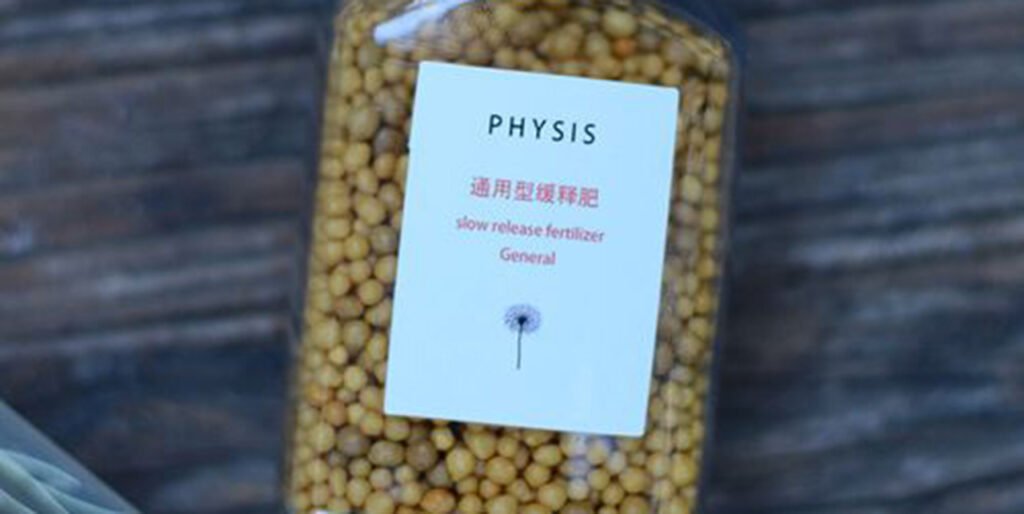
| Dimension | Slow-Release Fertilizer (SRF) | Controlled-Release Fertilizer (CRF) |
| Release Mechanism | Passive, slow dissolution or decomposition | Actively responds to environmental factors for precise release |
| Core Technology | Basic coating or chemical bonding | Smart polymer membrane-controlled release technology |
| Release Curve | Non-uniform; highly influenced by environmental conditions | Pre-set to release uniformly or in stages; highly controllable |
| Typical Products | Sulfur-coated urea, urea-formaldehyde | Polymer-coated compound fertilizers, temperature-responsive fertilizers |
| Cost-Effectiveness | Lower initial cost; moderate overall efficiency | Higher initial cost; significant long-term benefits |
1. Release mechanism: from "passive slowness" to "active regulation"
- The nutrient release of slow-release fertilizers (SRF) mainly depends on physical structure or chemical binding force, which belongs to the "non-precise control" mode. For example, sulfur-coated urea controls the dissolution rate through the coating thickness, or gradually decomposes and supplies nitrogen through chemically synthesized urea-formaldehyde compounds. Its release rate is greatly affected by environmental factors such as soil temperature, humidity, and microbial activity, and usually presents a non-uniform curve of "first fast and then slow".
- Controlled-release fertilizers (CRF) achieve "on-demand release" through intelligent coating materials, which belongs to the "precise control" mode. Typical examples include polymer-coated fertilizers, whose coating porosity has a quantitative response relationship with temperature and moisture - when the temperature rises, the expansion of the coating accelerates the release of nutrients, which fits the fertilizer requirement law during the growth period of the plant. The release curve is close to the preset linear or step-by-step mode, and the nutrient release cycle can be accurate to 30 days, 60 days or 90 days.
2. Material technology: from "basic coating" to "intelligent response"
- Common materials for SRF include sulfur, resin, paraffin, etc., and the process is relatively simple. For example, the coating of sulfur-coated urea is easily decomposed by soil microorganisms, and the release stability is poor, and "explosive release" may occur in hot and rainy environments.
- CRF relies on high molecular polymers (such as polyurethane and polyolefins) to form a semi-permeable membrane structure through nanoscale pore design and cross-linking density regulation. This material has a specific response to environmental factors (temperature, pH value, enzymes). For example, the release rate of some CRFs is less than 10% below 15°C, and the release rate increases to 50% at 25°C, which perfectly matches the temperature increase and fertilizer requirement of temperate crops after spring sowing.
3. Nutrient efficiency and environmental benefits
- The nitrogen, phosphorus and potassium utilization rate of CRF is 15%-20% higher than that of SRF on average: taking corn as an example, the nitrogen fertilizer utilization rate of CRF can reach 65%, while that of ordinary SRF is about 50%. This is because CRF can synchronize the peak of nutrient release with the peak period of crop root development (such as rice tillering period and fruit tree fruit swelling period), reducing leaching (loss reduced by 40%) and volatilization (loss reduced by 60%). In addition, CRF can significantly reduce non-point source pollution in farmland. When applied in water source protection areas, the amount of nitrate leaching is reduced by more than 30% compared with SRF.
- Due to the weak controllability of SRF release, it may cause nutrient waste in extreme climates (such as heavy rains and cold waves). There is still a slight risk of soil salinization after long-term use, but the cost is 20%-30% lower than CRF, which is suitable for conventional crops that do not require high precision.
4. Application scenarios and cost trade-offs
- Choose CRF: cash crops (such as greenhouse vegetables, citrus, grapes), large-scale precision planting scenarios (with drip irrigation systems), farmland in ecologically sensitive areas, or lazy agricultural models that require "one-time fertilization for the entire season". Although the unit price is high (500-1000 yuan per ton more expensive), the benefits of saving labor and increasing production are significant (for example, strawberry yield per mu increased by 20% after using CRF, and the rate of deformed fruit decreased by 40%).
- Choose SRF: ordinary field crops (corn, wheat), short-term fast-growing forage, and small-area planting with limited budgets are suitable for balancing nutrient needs through "low cost + multiple fertilization".
SCU Applications by Crop Type: From Cereal to Horticulture

3 Things to check before apply SCU to the corps: Soil testing, crop analysis, climate.
- Preliminary soil testing: test soil pH, nitrogen, phosphorus and potassium content, and organic matter status. In alkaline soils, the degradation of SCU sulfur coating slightly acidifies the soil, which can improve the soil environment; in acidic soils, it is necessary to assess whether it will aggravate the risk of acidification.
- Crop demand analysis: adjust the application strategy according to crop type and growth period. For field crops such as corn and wheat, SCU can be used as a base fertilizer before sowing to meet the needs of the entire growth period; for economic crops such as vegetables and fruit trees, it can be applied in batches in combination with the drip irrigation system, and appropriately supplemented during the key growth period (such as the fruit swelling period of fruit trees). In addition, for crops that are sensitive to sulfur, such as cruciferous vegetables, the application of SCU can also provide additional sulfur nutrition.
- Climate conditions consideration: pay attention to local temperature and precipitation patterns. In hot and rainy areas, the degradation rate of SCU sulfur coating is accelerated and the release cycle is shortened. The single application amount should be appropriately reduced to avoid excessive nutrient release in the early stage; in arid areas, on the contrary, the amount can be increased or strip application or hole application can be adopted to reduce the impact of water evaporation on release, and irrigation can be used to promote nutrient release.
How to choose the appropriate time to apply SCU?
- Early nitrogen application needs to be synchronized with the main growth stage of crops. For example, field crops such as corn and wheat should be applied 10-15 days after sowing (seedlings 3-4 leaves stage) to promote root development (data from the U.S. National Agricultural Statistics Bureau show that early nitrogen application can increase root length by 15%-20%).
- Crops with a long growth period (such as fruit trees and cotton) need to be applied in stages: basal fertilizer accounts for 60%-70% (deep application before budding), and topdressing 30%-40% in the middle period (fruit swelling stage/flowering and boll stage) to avoid fertilizer deficiency in the later stage.
- In hot and rainy areas: the degradation of sulfur coating is accelerated. It is recommended to reduce the single application amount by 10%-15% and apply it in 2 times (such as rice tillering stage + booting stage) to prevent the early "explosive release" of nitrogen. In arid areas, combine irrigation with application to accelerate the softening of the coating through water penetration.
How to determine the best dosage of SCU? How much to apply?
- Light fertilizer crops (such as forage and leafy vegetables): 30-60 kg per hectare (recommended by the Natural Resources Defense Council of the U.S. Department of Agriculture), sandy soil can float 10%;
- Heavy fertilizer crops (such as corn and fruit trees): 70-140 kg per hectare, combined with decomposed organic fertilizer (1000-2000 kg/mu) to improve fertilizer retention.
- Determine the soil available nitrogen content: when the background value is greater than 40mg/kg, the SCU dosage is reduced by 20%; when it is less than 20mg/kg, the dosage is increased by 15%;
- Evaluate pH value and organic matter: the ideal pH is 6.0-7.0, acidic soil (pH <5.5) needs to be adjusted with lime, and soil with organic matter <2% can increase the SCU application by 10%-15% (supported by data from the American Soil Association).
3 Tips for Maximizing the Efficiency of SCU Fertilizers
1. Depth and interval control:
The depth of mechanical application is 8-12 cm, and the depth can be increased to 15 cm in sandy soil to avoid direct contact with seeds (5-10 cm interval to prevent seed burning), and nitrogen volatilization loss can be reduced by more than 50%.
2. Nutrient synergy strategy:
Apply phosphorus and potassium fertilizers: The base fertilizer combination of corn is SCU 15 kg + superphosphate 25 kg + potassium sulfate 5 kg / mu to improve nutrient balance;
Complementary with trace elements: zinc-deficient soil (effective zinc <0.5mg/kg) can be superimposed with zinc-coated urea to reduce the amount of SCU by 10%.
3. Environmental risk prevention and control:
- Avoid excessive application: The nitrogen input in the season should not exceed 120% of the crop demand to prevent nitrate nitrogen leaching (when the recommended amount is exceeded, the leaching risk increases by 30%);
- Saline-alkali land improvement: Sulfuric acid produced by the degradation of SCU sulfur coating can slightly acidify the soil (reducing the pH value by 0.2-0.3 per mu), and the effect is better when combined with gypsum.
Environmental Impact: Can SCU Reduce Nitrate Runoff & Greenhouse Gases
1. Environmental protection and ecological maintenance
Controlled-release fertilizers (CRFs) have shown significant advantages in environmental protection and ecological maintenance due to their unique nutrient release mechanism. On the one hand, CRFs effectively reduce the risk of nutrients such as nitrogen and phosphorus entering water bodies due to leaching and runoff by precisely regulating the nutrient release rate to synchronize it with the plant absorption rate. Research data shows that compared with traditional fertilizers, the use of CRFs can reduce nitrogen losses by about 30%, greatly alleviating the problem of eutrophication of water bodies, and is of great significance to the protection of aquatic ecosystems such as rivers and lakes. On the other hand, CRFs also play a key role in reducing greenhouse gas emissions. Its slow release characteristics avoid drastic fluctuations in nitrogen concentration in the soil and inhibit the process of soil microorganisms converting nitrogen into nitrous oxide (N2O). As a potent greenhouse gas, N2O emissions are effectively controlled due to the application of CRFs, helping to slow down global warming.
2. Stable nutrient supply
At the soil ecological level, CRF's continuous and stable nutrient supply mode is in sharp contrast to the drastic fluctuations in soil microbial communities caused by traditional fertilizers. After the large-scale application of traditional fertilizers, soil microorganisms surge in a short period of time, and then decline due to nutrient depletion. This process will destroy the stability of the soil microbial community. The progressive nutrients provided by CRF create a more suitable and stable living environment for microorganisms, help build a balanced and active soil microbial ecosystem, promote the formation of soil aggregate structure, and improve the soil's ability to retain water and fertilizer, thereby maintaining and enhancing soil fertility and achieving long-term improvement of soil health.
3. Scientifically designed nutrient release rate of CRF
From the perspective of technical parameters, the nutrient release rate of CRF is scientifically designed to closely fit the plant growth cycle and minimize nutrient loss; its significantly reduced nitrous oxide emissions directly affect the greenhouse gas emission reduction target; and the stable nutrient release characteristics play a positive role in improving soil fertility and stabilizing the ecosystem by maintaining microbial activity. These characteristics make CRF an optimal choice for modern agricultural production that is both efficient and environmentally friendly, and provide strong support for reducing agricultural non-point source pollution and promoting the healthy development of the ecosystem.
How Sulfur-Coated Urea Fertilizers Improve NUE?
Sulfur-coated urea (SCU) improves (NUE)nitrogen utilization through three mechanisms:
- first, the sulfur coating gradually dissolves in the soil to form micropores, allowing urea to diffuse and release slowly, avoiding ammonia volatilization or leaching losses caused by excessive one-time release;
- Second, the oxidation of the sulfur layer by soil microorganisms will destroy the coating structure, prompting urea to be released on demand, which is more in line with the fertilizer requirements of crops;
- Third, the coating blocks the direct contact between urea and soil urease, slowing down the speed of urea hydrolysis to ammonium nitrogen, reducing the escape of nitrogen into the atmosphere in the form of ammonia gas, and reducing the risk of nitrate nitrogen being lost with water, thereby increasing nitrogen utilization from 30%-40% of ordinary urea to 60%-70%.
What Is The Future of SCU? Market Trends & Outlook for 2025–2030
Judging from the actual situation of the global market, sulfur-coated urea (SCU) is expected to see significant development between 2025 and 2030. At present, the demand for environmentally friendly and efficient fertilizers in agricultural production continues to rise, which creates a broad space for SCU.
In 2023, the global sulfur-coated urea market size reached 10.725 billion yuan, and it is expected to grow to 15.479 billion yuan by 2029, with an annual compound growth rate of about 5.91%. As a major agricultural production region, the Asia-Pacific region has become the main consumer area for SCU due to its huge demand for food and agricultural products. With the advancement of agricultural modernization, farmers pay more and more attention to fertilizer utilization and environmental protection performance. SCU, with its slow-release characteristics, reduces nitrogen loss and improves utilization, which meets this demand trend and has a bright future in the Asia-Pacific market.
In terms of technological innovation, enterprises and scientific research institutions continue to explore and optimize SCU coating materials and processes to make the nutrient release curve more in line with the needs of the entire growth period of crops. For example, by improving the sulfur coating formula and precisely controlling the nitrogen release at different stages, the fertilizer effect can be further improved, promoting the market's acceptance of SCU.
Of course, the development of SCU also faces challenges, such as relatively high production costs, which limit its promotion in price-sensitive markets. However, as economies of scale emerge and costs fall due to advances in coating technology, this obstacle will gradually weaken. Overall, from 2025 to 2030, sulfur-coated urea will have a relatively optimistic outlook driven by market demand, technological innovation and policy support, and is expected to occupy a more important position in the global fertilizer market.
SCU Production Line Overview: Technology, Coating Methods & Capacity Planning
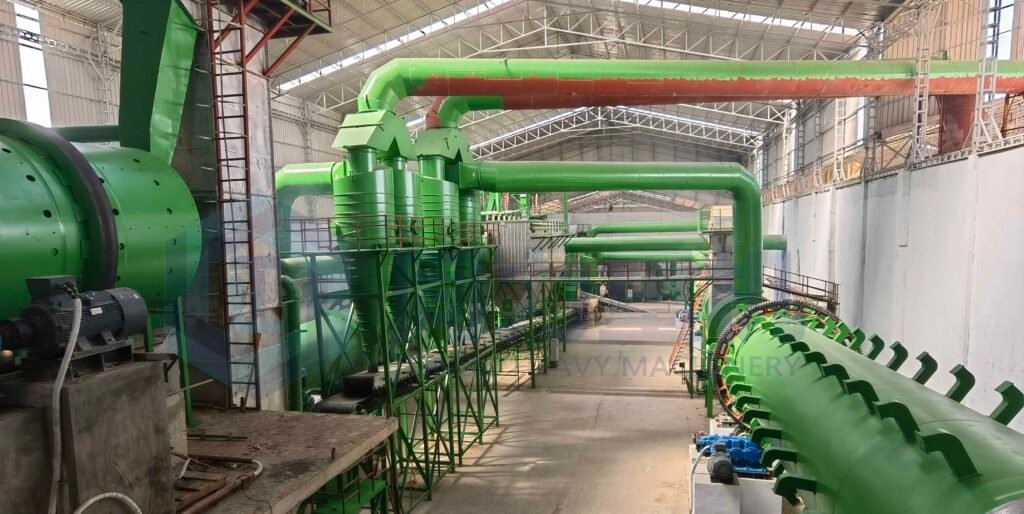
SO regarding this topic we have already made an in depth article about it, please check it out by the link below: What is Sulfur Coated Urea SCU Fertilizer Production Line? Manufacturer’s Detailed Explanation
- Coating machine innovation: The new rotary drum coating machine adopts an inclined drum + scraper structure. The material moves in a spiral motion in the drum to ensure uniform coating of the sulfur liquid; the scraper cleans the inner wall residue in real time to reduce agglomeration and improve the coating quality.
- Nozzle and atomization technology: Multiple groups of molten sulfur nozzles spray evenly at a pressure of 0.35MPa, and the independent design of the atomization area (the end points of the atomization areas of adjacent nozzles overlap) is used to avoid uneven coating thickness. The nozzle adopts an inclined feed channel + atomization wall impact structure. The liquid sulfur impacts the atomization wall at an acute angle, which improves the atomization effect by 40% and significantly improves the coating uniformity.
- Temperature control and drying system: The inlet temperature of the coating machine is controlled at 95-110°C and the outlet temperature is 45-55°C. The urea particles are preheated by downstream heat exchange to ensure rapid solidification of the sulfur liquid; the supporting fluidized bed drying technology further reduces the moisture content and prevents cracking of the coating.
Frequently Asked Question About SCU, People Also Ask.
Sulfur-coated urea (SCU) improves nitrogen utilization efficiency through three mechanisms: first, the sulfur coating forms a physical barrier that delays soil water penetration, allowing the urea to gradually dissolve as the sulfur layer or be oxidized by microorganisms and slowly released, avoiding ammonia volatilization and leaching caused by rapid hydrolysis of traditional urea; second, sulfur is oxidized to form sulfuric acid during coating degradation, which can lower the pH of alkaline soil and reduce the loss of ammonium nitrogen converted into ammonia, while optimizing microbial activity to promote nitrogen absorption; third, its release cycle is more in line with the fertilizer requirements of crops. For example, nitrogen is supplied slowly in the early growth stages of crops such as corn, and released faster in the middle and late stages as the temperature rises, increasing the nitrogen utilization rate from 30%-40% of ordinary urea to 60%-70%, and reducing the frequency of topdressing, thereby reducing the risk of nitrogen loss in the environment.
In agriculture, nitrogen use efficiency (NUE) refers to the proportion of nitrogen absorbed by crops from applied nitrogen fertilizers and used for growth, development and yield formation. NUE can be divided into uptake efficiency and utilization efficiency. Absorption efficiency refers to the ability of plant roots to absorb nutrients such as nitrogen from the soil, while utilization efficiency refers to the ability to convert absorbed nutrients into biomass or yield. It comprehensively reflects the efficiency of nitrogen fertilizer retention, conversion and utilization by crops in the soil, and is affected by soil properties, climatic conditions, crop varieties, fertilization methods (such as dosage, period, method) and other factors. High NUE indicates that plants can effectively use existing nutrients to achieve optimal growth, thereby reducing the need for additional fertilization.
Sulfur-coated urea (SCU) significantly improves the utilization rate of nitrogen fertilizer through a unique slow-release technology. The core is to encapsulate urea particles in a sulfur coating, which will slowly degrade in the soil to achieve controlled and sustained release of nitrogen. The nitrogen release cycle is usually 40 to 90 days, which can be flexibly adjusted according to the coating thickness and environmental conditions, highly consistent with the crop growth stage, and ensure a continuous supply of nutrients. Compared with traditional urea, SCU can reduce nitrogen leaching losses by up to 30% and volatilization losses by 50%, effectively reducing the risk of nitrogen loss. Although the initial procurement cost is high, it has significant cost-effectiveness in the long run by reducing the total amount of nitrogen fertilizer used by 20% and reducing the potential cost of environmental governance. These characteristics not only help increase crop yields, but also reduce nitrogen pollution, achieving a win-win situation for economic and ecological benefits of agricultural production.
Slow-release fertilizers (SRF) release nutrients slowly through physical coating or chemical binding, but their speed is mainly affected by the soil environment. Controlled-release fertilizers (CRF) use temperature/moisture-responsive smart coating materials to actively regulate the release rhythm, making nutrient supply highly synchronized with crop fertilizer requirements. Although the technology is more complex and the cost is 15%-30% higher, the utilization rate of nitrogen and phosphorus is increased by more than 20% and the environmental risks are lower.
Sulfur-coated urea is often classified as a controlled-release fertilizer because it forms a barrier through a sulfur coating, and regulates the nitrogen release rate according to soil temperature and humidity conditions. Sulfur-coated granules wrap urea under a thin coating, which is mainly composed of sulfur, and sometimes polymer sealants are added to delay its release in the soil. As the sulfur coating or polymer coating layer decomposes, urea is slowly released, providing plants with an uninterrupted supply of nitrogen. However, strictly speaking, its release is greatly affected by the environment and is closer to a slow-release fertilizer. It is only in some scenarios that it is generally referred to as a controlled-release fertilizer because it has certain regulatory characteristics.
Conclusion:
So to summarize, sulfur-coated urea (SCU) is a highly efficient controlled-release fertilizer, is gradually occupying an important position in agricultural practice. Its mechanism of action is to coat the urea particles with a layer of sulfur and waxy sealant to achieve slow release of nutrients. This design effectively reduce nitrogen leaching and volatilization, prolong the available time of nitrogen in the soil, also provide crops with sulfur elements required for growth, and has dual nutrient functions. With the growing demand for both environmental protection and high efficiency in agriculture, controlled-release fertilizer technologies such as SCU are seen as an important direction for future fertilizer development.

